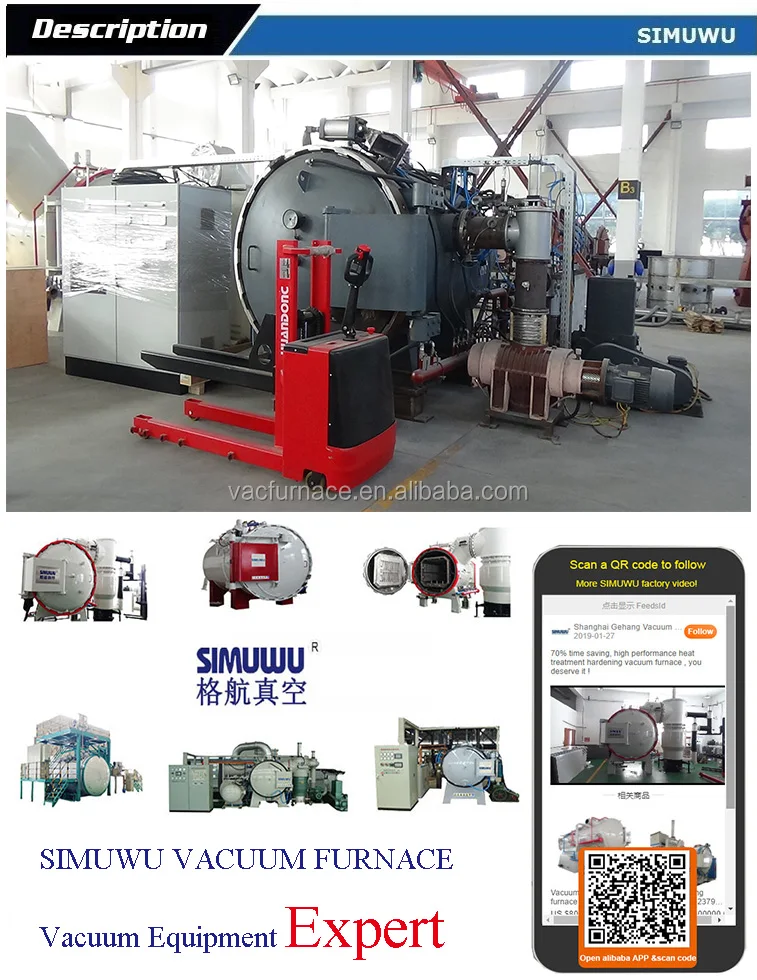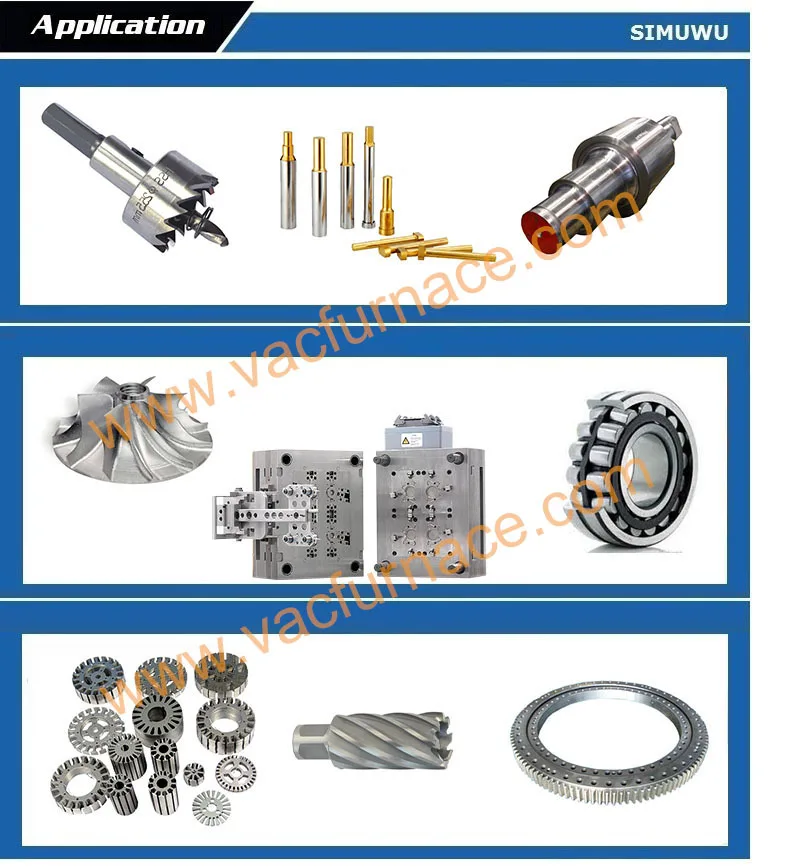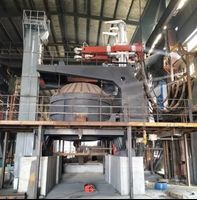High speed steel mould steel H13 D2 440C heat treatment furnace
-
Supplier: Shanghai Gehang Vacuum Technology Co., Ltd. -
Region: Shanghai, China -
Contact: Mr Hang Ge -
Price: $80000.00 /unit -
Min. Order: 1 unit
| Structure: | Horizontal, vertical, batch, continuous; | Dimension(L*W*H): | custom made; |
| Warranty: | 1 Year; | Payment Terms: | L/C,D/A,D/P,T/T,MoneyGram,vacuum hardening furnace for D2 1.2379 XW-41 SKD11 Die steel mou; |
| After-Sales Service: | 1 year; | Certification: | CE, ISO9001; |
| Vacuum system: | Leybold, EVP, Edwards, Kinney; | Supply Ability: | 4 Unit/Units per Month vacuum hardening furnace for D2 1.2379 XW-41 SKD11 Die steel mou; |
| Packaging Detail: | 20'/40' Open top container or 20'/40' Flat rack container High speed steel mould steel H13 D2 440C heat treatment furnace; | Chamber material: | Cast iron, stainless steel, optional; |
| Type: | Vacuum Hardening Furnace; | PLC controller: | SIEMENS, MITSUBISHI, LG; |
| Heating method: | resistance, induction; | Heater: | Mo belt, Tungsten, Graphite, SiMo, SiC; |
| Brand Name: | SIMUWU; | Voltage: | 380V (adjustable); |
| Weight: | 2T-35T; | Max temperature: | 500C - 1800C (custom made); |
| Power(W): | adjustable; | Condition: | New; |
| Usage: | Heat Treatment Furnace; | Loading capacity: | 3000kg (adjustable); |
| After-sales Service Provided: | Free spare parts,Field installation, commissioning and training,Field maintenance and repair service,Video technical support,Online support; | Temperature uniformity: | ±5 C; |
| Port: | Shanghai; | Place of Origin: | Shanghai China; |
High speed steel mould steel H13 D2 440C heat treatment furnace

Vacuum hardening furnace for D2 1.2379 XW-41 SKD11 Die steel, mould steel
Vacuum Technology is the Basis for Process Innovation in Heat Treatment.
Heat Treatment is the process in which metallic/steel parts are exposed completely or partially to time-temperature sequences in order to change the mechanical and/or corrosion properties. There are numerous application areas, e.g.:
• Annealing • Hardening • Tempering • Aging • Case hardening
To achieve a higher strength of the material, better wear resistance or to improve the corrosion behaviour of the components.All of these processes need a temperature up to 1.000 °C and higher as well as especially developed furnaces to achieve such ranges.
Vacuum Annealing
Annealing is one type of heat treatment comprising heating up to a specific temperature, holding and cooling down slowly. Such processes are generally used to obtain a softer structure of the part and to optimise material structure for subsequent working steps (machining, forming). Parameters depend on the material and the desired structure.
Vacuum Hardening and Tempering
Hardening is a typical heat treatment process combining heating to specific temperatures (mostly above 900 °C) and direct fast cooling or quenching of the part. The requirements are selected to change the materials’ structure partially or completely into martensite. The part undergoes tempering treatment after hardening in order to obtain high ductility and toughness.
Vacuum Case Hardening
One of the important processes is the case hardening or carburizing process. Parts are heated up to 900 °C - 1.000 °C and by adding specific gases (hydrocarbons) into the atmosphere of the furnace the part’s surface is enriched by absorbing carbon. Following this treatment the part is quenched in order to achieve the required properties. This results in higher resistance to stresses and friction on the component’s surface. The core of the part remains somewhat softer and more ductile which allows the part to carry high stresses through its entire life. For example, all gear parts for transmissions are treated this way.
New vacuum quenching technology,75% process time saving
Name | Parameter |
vacuum heat treatment furnace (hardening, annealing, tempering, quenching) | steel heat treatment |
Model | Horizontal / Vertical |
Ultimate vacuum | Custom made |
Pressure rising rate | 0.5pa/h ( adjustable ) |
Max temperature | Custom made |
Temperature uniformity | ±3℃ / ±5℃ |
Heating power | Custom made |
Temperature control method | Intelligent programmable temp controller |
Control method | PLC auto/manual interlock protection |
Max gas charging pressure (absolute pressure) | Custom made |
Specification
Main technical data of vacuum heat treatment furnace | ||||||
Models | Effective working dimension (mm) | Max temperature (C) | Ultimate pressure (pa) | Pressure rising rate (pa/h) | Temperature uniformity (C) | Loading capacity (kg) |
RVGQ-224 | 250x250x400 | 500-1300 | 4x10-1 | 0.5 | ±5 | 50 |
RVGQ-335 | 300x300x500 | 500-1300 | 4x10-1 | 0.5 | ±5 | 100 |
RVGQ-446 | 400x450x600 | 500-1300 | 4x10-1 | 0.5 | ±5 | 200 |
RVGQ-558 | 500x500x800 | 500-1300 | 4x10-1 | 0.5 | ±5 | 300 |
RVGQ-669 | 600x600x900 | 500-1300 | 4x10-1 | 0.5 | ±5 | 500 |
RVGQ-7710 | 700x700x1000 | 500-1300 | 4x10-1 | 0.5 | ±5 | 800 |
RVGQ-8812 | 800x800x1200 | 500-1300 | 4x10-1 | 0.5 | ±5 | 1200 |
RVGQ-vertical 70x11 | Φ700x1100 | 500-1300 | 4x10-1 | 0.5 | ±5 | 800 |
RVGQ- x | custom made | custom made | custom made | custom made | custom made | custom made |

Application fields: Die steel, stainless steel, gear, high speed steel, tool steel and so on.
Advantages of Vacuum Heat Treatment
Vacuum as "Protective Atmosphere"
• No toxic protective gases containing CO
• No health hazards in the work shop
• No danger of explosion or open flames
• No furnace conditioning
• Use of inert gases (nitrogen or helium)
• No CO2 emission
Vacuum Carburizing
• Use of various processes
• Use of different gases
• Shorter carburizing cycles than in conventional technology
• Higher carburizing temperatures offer potential to further reduce process time
• Small gas consumption l instead of m3
Gas Quenching Instead of Oil Quenching
• Clean, dry parts after hardening
• No washing machine - no disposal of washing water
• No maintenance of washing equipment
• No complicated washing water chemistry
• Saves space
• Cost benefits
• Quenching intensity is controlled via gas pressure or gas velocity
• No vapor blankets during quenching
• Homogeneous quenching
• Reduced distortion
Surface Influences
• Free of surface oxidation
• No surface decarburization
• Bright, metallic, shiny parts
Plant Operation / Installation / Maintenance
• No idling over the weekend
• No continuous gas consumption
• Short heat-up times
• Fast access to installed modules
• No fire detection or sprinkler system
• No open flames
• No flammable gas mixtures
• Cold-Wall Technology
• No gas emission
• Minimum energy loss
• No heat radiation to atmosphere
Auxiliary Equipment of Protective Gas Plants are no longer required, like:
• Fire safety equipment
• Sprinkler system
• Exhausts
• CO2 extinguisher for the oil bath
• Measuring CO concentration in the shop
• Smoke exhaust in the roof (automatic opening and closing)
• Oil-proof floor or tank
• Methanol storage
Click here for more informations !






Click here for more informations !





 Click here for more informations !
Click here for more informations !
-
Best Selling Electric Arc Furnace Graphite Electrode for Electric Arc Furnace 5 Ton Refractory Electric Arc Furnace

-
Prebaked consumable carbon anode block for aluminum smelting

-
Professional production of high-quality imported high-temperature resistant belts for industrial furnaces

-
Sell Gold Smelting Furnace

-
Mini electric furnace for melting tin, silver, copper, aluminum, gold, melting furnace, melting furnace

-
Copper and aluminum scrap casting 150KG 200KG 300KG 1.5 tons for casting copper zinc lead ingot casting machine

-
Electric Industry Foundry 1 Ton Scrap Iron Induction Melting Furnace Machine For Sale

-
High Speed Aluminum Recycling Scrap Melting Furnace Aluminum Melting Furnace

-
Ex-factory price gas melting gold furnace

-
In 2022, the new machine laboratory will use a 15kw vacuum precious metal melting furnace to smelt rhodium and boron

Other Products
-
 $60000.00 / set
$60000.00 / set -
 $50000.00 / set
$50000.00 / set -
 $60000.00 / set
$60000.00 / set -
 $8000.00 / set
$8000.00 / set















